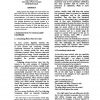Free Online Productivity Tools
i2Speak
i2Symbol
i2OCR
iTex2Img
iWeb2Print
iWeb2Shot
i2Type
iPdf2Split
iPdf2Merge
i2Bopomofo
i2Arabic
i2Style
i2Image
i2PDF
iLatex2Rtf
Sci2ools
96
Voted
ACL
1990
1990
Lexical and Syntactic Rules in a Tree Adjoining Grammar
according to this definition2. Each elementary tree is constrained to have at least one terminal at its frontier which serves as 'head' (or 'anchor'). Sentences of a Tag language are derived from the composition of an S-rooted initial tree with other elementary trees by two operations: substitution (the same operation used by context free grammars) or adjunction, which is more powerful. Taking examples from English and French idioms, this paper shows that not only constituent structures rules but also most syntactic rules (such as topicalization, wh-question, pronominalization ...) are subject to lexical constraints (on top of syntactic, and possibly semantic, ones). We show that such puzzling phenomena are naturally handled in a 'lexJcalized'formalism such as Tree Adjoining Grammar. The extended domain of locality of TAGs also allows one to 'lexicalize' syntactic rules while defining them at the level of constituent structures.
Related Content
| Added | 06 Nov 2010 |
| Updated | 06 Nov 2010 |
| Type | Conference |
| Year | 1990 |
| Where | ACL |
| Authors | Anne Abeillé |
Comments (0)

